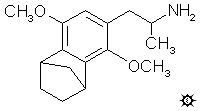
#84 G-5
3,6-DIMETHOXY-4-(2-AMINOPROPYL)BENZONORBORNANE
|
| [3D .mol structure] |
A solution of LAH (50 mL of 1 M solution in THF) was cooled, under He, to 0 °C with an external ice bath. With good stirring there was added 1.32 mL 100% H2SO4 dropwise, to minimize charring. This was followed by the addition of 4.1 g 3,6-dimethoxy-4-(2-nitropropenyl)benzonorbornane in 20 mL anhydrous THF over the course of 10 min. The reaction mixture was stirred and brought to room temperature over the course of 1 h. This was then brought to a gentle reflux on the steam bath for 0.5 h, and then all was cooled again to 0 °C. The excess hydride was destroyed by the cautious addition of 10 mL IPA followed by 5 mL 5% NaOH and sufficient H2O to give a white granular character to the oxides. The reaction mixture was filtered, and the filter cake washed with THF. The filtrate was stripped of solvent under vacuum providing a pale amber oil that was distilled at 125-140 °C at 0.2 mm/Hg to give 2.5 g of an almost white oil. This was dissolved in 10 mL IPA, neutralized with 25 drops of concentrated HCl, and then diluted with 140 mL anhydrous Et2O. There appeared, after about two minutes, white crystals of 3,6-dimethoxy-4-(2-aminopropyl)benzonorbornane hydrochloride (G-5) which, after filtration and air drying, weighed 2.47 g.
DOSAGE: 14 - 20 mg.
DURATION: 16 - 30 h.
QUALITATIVE COMMENTS: (with 15 mg) As part of the audience at the San Francisco conference, Angels, Aliens and Archtypes, I could simply listen and observe without having to participate. Each speaker stood in a cone of light that was beautifully bright and colorful, casting everything else on the stage into obscurity. Maybe angels really are illuminated from above, and the aliens lurk out of sight until it is their turn. Where does one look for the archetypes? A half of a cream cheese sandwich was all I could eat, and even at dinner that evening I was not hungry. Sleep that evening was difficult.
(with 20 mg) Very slow to come on, but then it was up there all of a sudden. There is an unexpected absence of visual activity despite being at a full +++. The mental activity is excellent, with easy writing and a positive flow of ideas. But an absence of the bells and whistles that are expected with a psychedelic in full bloom. There is a real drop by the 16th hour and the next day was free of effect except for occasional cat-naps.
(with 20 mg) The transition period, which usually lasts for most compounds for the first hour or two, with this seems to be much longer. This presages a long-acting material, as usually the slow-in slow-out rule applies. But there are exceptions. There is an indifference towards the erotic, but no separation at all from personal interactions and emotions. I believe in integration, not separation of all parts of ourselves, distrusting any drug states (particularly those that have the reputation of being strongly `cosmic') which divorce the consciousness from the body. And with this material there is no separation from feelings, only from my particular color language.
EXTENSIONS AND COMMENTARY: This is as potent as any of the three-carbon Ganesha compounds, but it somehow lacks a little something that would have made it a completely favorite winner. Perhaps it is the generally commented upon absence of visual and related sensory entertainment. There seems to be no bodily threat to discourage further exploration, but there simply was not the drive to explore it much. The comments concerning the enlargement of the ring system (mentioned under 2C-G-5) are equally valid here. The "shrubbery" that is the hallmark of the Ganesha family is, with G-5, about as bulky as has ever been put onto a centrally active molecule. The norbornane group has a one carbon bridge and a two carbon bridge sticking out of it at odd angles. The replacement of the one-carbon bridge with a second two-carbon bridge would make the compound G-6. It would be makeable, but is there really a driving reason to do so? There is a simplification intrinsic in this, in that G-5 actually has two centers of asymmetry (the alpha-carbon atom on the amphetamine chain, and the norbornyl area itself) and so it is really a mixture of two racemic diastereoisomers. G-6 would still be a racemate, but it would be only a single compound, as are all the other substituted amphetamine derivatives.
Someday I may try making G-6, but it's not a high priority right now.
| [ |
[Main Index] | [Forward |

